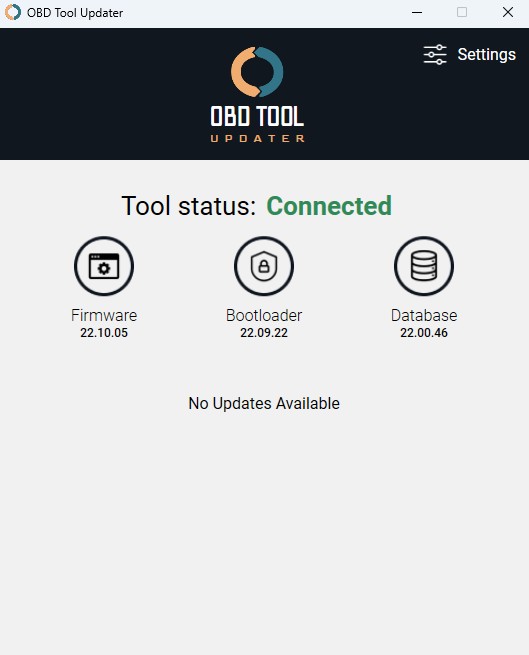Maintaining your vehicle’s health is crucial, and your OBD2 scanner is an indispensable tool in this process. Like any electronic device, your OBD2 scanner requires regular updates to ensure it functions optimally and provides the most accurate diagnostic information. This guide will walk you through how to update your OBD2 scanner, troubleshoot common issues, and keep your device performing at its peak.
Checking for Updates: Is Your OBD2 Scanner Up-to-Date?
It’s essential to regularly check for updates for your OBD2 scanner. Manufacturers like Innova frequently release firmware and software updates to enhance functionality, add new vehicle coverage, and fix bugs. Using an outdated scanner can lead to inaccurate readings or missing out on critical diagnostic features.
Typically, you can check for updates by connecting your OBD2 scanner to your computer via a USB cable and using the manufacturer’s update software. This software will automatically detect your device and check for available updates.
If your scanner is already up-to-date, the software will notify you that “No updates are available,” as shown in the image above. This is great news, meaning your device is running on the latest software version. If you’ve recently updated your scanner or purchased a new one, this is likely the case.
To stay informed about future updates, consider subscribing to the manufacturer’s update notification list. This ensures you’ll be among the first to know when new firmware becomes available, keeping your scanner at the cutting edge of automotive diagnostics.
Troubleshooting Connection Issues During Updates
Sometimes, you might encounter connection problems when trying to update your OBD2 scanner. If your computer isn’t recognizing your device, or the update software isn’t connecting, try these simple troubleshooting steps:
- Check the USB Connection: The most common culprit is a loose USB connection. Unplug the USB cable from both your computer and the OBD2 scanner, and then firmly replug them. Ensure the cable is securely fastened in both ports.
- Try a Different USB Port: USB ports can sometimes malfunction. Switch to a different USB port on your computer to rule out a port issue.
- Use a New USB Cable: While less frequent, USB cables can degrade or become faulty over time. Trying a new, high-quality USB cable can resolve connection problems.
By systematically checking these connection points, you can often resolve the issue and establish a stable link for the update process.
Performing the Update: Step-by-Step
When an update is available for your OBD2 scanner, the update software will display a screen similar to the one below, prompting you to update.
To initiate the update, simply click the “Update my tool now” button. The update process may take some time, potentially up to 25 minutes, depending on the update size and your internet speed. Crucially, do not disconnect the OBD2 scanner during the update process. Disrupting the update can cause errors and potentially damage your device’s firmware.
Resolving Common Update Errors and Issues
Even with careful execution, you might encounter errors during the update process. Here are solutions to some common problems:
“Update Error” Message: If you see an “Update Error” message, the most common fix is to simply try the update again. This error often arises from temporary internal glitches during the update process. Reconnect your scanner, restart the update software, and attempt the update once more. Also, double-check that your USB cable is firmly connected to prevent interruptions.
Update Stuck at a Certain Percentage (e.g., 5%): If the update progress bar freezes at a low percentage for an extended period, it usually indicates that your OBD tool updater software is outdated. To resolve this:
- Re-download the Updater Software: Go to the manufacturer’s website and download the latest version of the OBD tool updater software.
- Repair the Software Installation: When running the downloaded installer, you’ll typically be presented with options like “Modify,” “Replace,” or “Repair.” Select “Repair“. This will update the existing software installation to the newest version without requiring a full reinstallation.
- Retry the Update: After repairing the software, attempt the OBD2 scanner update again. The updated software should resolve the issue and allow the update to proceed smoothly.
Still Unable to Download the Updater App: If you’re having trouble downloading the updater application itself, even after following the provided instructions, try these steps:
- Reboot Your Computer: A simple reboot can often resolve temporary software conflicts preventing downloads.
- Temporarily Disable Antivirus Software: In rare cases, overly aggressive antivirus programs can interfere with software downloads and installations. Temporarily disable your antivirus software and attempt to download the updater app again. Remember to re-enable your antivirus software afterward.
- Contact Customer Support: If you’ve exhausted these troubleshooting steps and are still facing issues, don’t hesitate to contact the manufacturer’s customer support team. They can provide personalized guidance and assistance to resolve your specific problem.
By keeping your OBD2 scanner updated, you ensure its accuracy, expand its vehicle compatibility, and benefit from the latest features. Regular updates are a key aspect of maintaining your scanner’s value and effectiveness as a vital automotive diagnostic tool.

